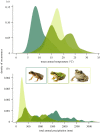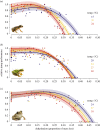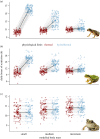Hydrothermal physiology and climate vulnerability in amphibians
- PMID: 33593188
- PMCID: PMC7934955
- DOI: 10.1098/rspb.2020.2273
Hydrothermal physiology and climate vulnerability in amphibians
Abstract
Concerns over the consequences of global climate change for biodiversity have spurred a renewed interest in organismal thermal physiology. However, temperature is only one of many environmental axes poised to change in the future. In particular, hydrologic regimes are also expected to shift concurrently with temperature in many regions, yet our understanding of how thermal and hydration physiology jointly affect performance and fitness is still limited for most taxonomic groups. Here, we investigated the relationship between functional performance, hydration state and temperature in three ecologically distinct amphibians, and compare how temperature and water loss can concurrently limit activity under current climate conditions. We found that performance was maintained across a broad range of hydration states in all three species, but then declines abruptly after a threshold of 20-30% mass loss. This rapid performance decline was accelerated when individuals were exposed to warmer temperatures. Combining our empirical hydrothermal performance curves with species-specific biophysical models, we estimated that dehydration can increase restrictions on species' activity by up to 60% compared to restriction by temperature alone. These results illustrate the importance of integrating species' hydration physiology into forecasts of climate vulnerability, as omitting this axis may significantly underestimate the effects of future climate change on Earth's biological diversity.
Keywords: dehydration; desiccation; ecophysiology; frogs; global change; thermal performance.
Figures



Similar articles
-
Response to thermal and hydric regimes point to differential inter- and intraspecific vulnerability of tropical amphibians to climate warming.J Therm Biol. 2022 Jan;103:103148. doi: 10.1016/j.jtherbio.2021.103148. Epub 2021 Dec 4. J Therm Biol. 2022. PMID: 35027199
-
Thermal physiological traits in tropical lowland amphibians: Vulnerability to climate warming and cooling.PLoS One. 2019 Aug 1;14(8):e0219759. doi: 10.1371/journal.pone.0219759. eCollection 2019. PLoS One. 2019. PMID: 31369565 Free PMC article.
-
Thermal niche predicts tolerance to habitat conversion in tropical amphibians and reptiles.Glob Chang Biol. 2015 Nov;21(11):3901-16. doi: 10.1111/gcb.13016. Epub 2015 Sep 22. Glob Chang Biol. 2015. PMID: 26148337
-
Review and synthesis of the effects of climate change on amphibians.Integr Zool. 2013 Jun;8(2):145-61. doi: 10.1111/1749-4877.12001. Integr Zool. 2013. PMID: 23731811 Review.
-
The thermal ecology and physiology of reptiles and amphibians: A user's guide.J Exp Zool A Ecol Integr Physiol. 2021 Jan;335(1):13-44. doi: 10.1002/jez.2396. Epub 2020 Jul 8. J Exp Zool A Ecol Integr Physiol. 2021. PMID: 32638552 Review.
Cited by
-
Combined climate change and dispersal capacity positively affect Hoplobatrachus chinensis occupancy of agricultural wetlands.iScience. 2024 Aug 17;27(9):110732. doi: 10.1016/j.isci.2024.110732. eCollection 2024 Sep 20. iScience. 2024. PMID: 39310775 Free PMC article.
-
Behavioural hydroregulation protects against acute effects of drought in a dry-skinned ectotherm.Oecologia. 2023 Feb;201(2):355-367. doi: 10.1007/s00442-022-05299-1. Epub 2022 Dec 23. Oecologia. 2023. PMID: 36564481
-
Surviving on the edge: present and future effects of climate warming on the common frog (Rana temporaria) population in the Montseny massif (NE Iberia).PeerJ. 2023 Jan 13;11:e14527. doi: 10.7717/peerj.14527. eCollection 2023. PeerJ. 2023. PMID: 36655044 Free PMC article.
-
From the Field to the Lab: Physiological and Behavioural Consequences of Environmental Salinity in a Coastal Frog.Front Physiol. 2022 Jun 2;13:919165. doi: 10.3389/fphys.2022.919165. eCollection 2022. Front Physiol. 2022. PMID: 35721550 Free PMC article.
-
Impacts of behaviour and acclimation of metabolic rate on energetics in sheltered ectotherms: a climate change perspective.Proc Biol Sci. 2024 Feb 28;291(2017):20232152. doi: 10.1098/rspb.2023.2152. Epub 2024 Feb 21. Proc Biol Sci. 2024. PMID: 38378146 Free PMC article.
References
Publication types
MeSH terms
Associated data
LinkOut - more resources
Full Text Sources
Other Literature Sources
Medical

